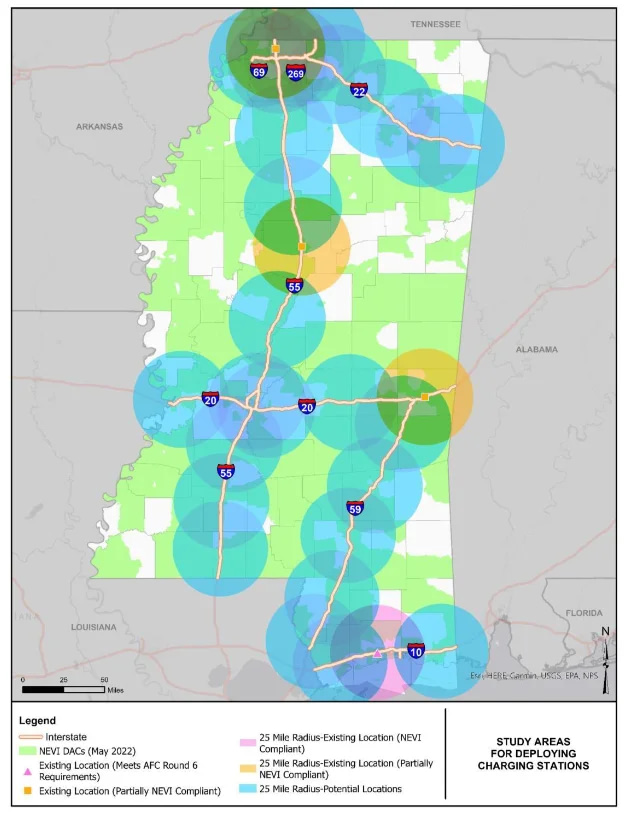The Mississippi Department of Transportation (MDOT) has been working to engage the public as it develops the state’s electric vehicle charging infrastructure through the National Electric Vehicle Infrastructure (NEVI) Formula Program. According to MDOT’s Electric Vehicle Infrastructure Deployment Plan, initial outreach focused on boosting awareness of the program and gathering industry feedback.
Mississippi FY 2024 Approved Plan
All of the interstates nominated to this point by Mississippi for EV AFCs were approved by FHWA in 2022. No new EV AFCs were proposed in 2023. Based on the requirements of the NEVI Formula Program discussed earlier, MDOT determined the approximate areas of proposed installations as well as the existing EV charging locations that may be upgraded.
During the implementation of EV charging infrastructure, EV network providers will work with MDOT, utility companies, and private businesses to finalize the charging infrastructure locations along AFCs. Table 8-2 displays the minimum number of required stations needed along each AFC to meet the NEVI requirement of a station every 50 miles, no more than 25 miles from the EV AFC corridor termini, and at least two along each AFC route.
| Interstate | Miles | Minimum Number of Locations |
|---|---|---|
| I-10 | 77.676 | 2 |
| I-20 | 131.575 | 4 |
| I-22 | 106.7 | 4 |
| I-55 | 280.572 | 7 |
| I-59 | 171.501 | 5 |
| I-69 | 22.395 | 2 |
| I-269 | 26.03 | 2 |
| Total | 26 |

In 2022, MDOT identified seven alternative fuel corridors that will serve as the backbone of Mississippi’s emerging EV charging network. All of these corridors either traverse or provide access to disadvantaged communities (DACs). With this in mind, MDOT has made targeted outreach to DACs a priority for the program’s next phase.
As part of updating its EV deployment plan this year, MDOT conducted additional public engagement aimed specifically at soliciting input from DACs. The agency developed and distributed a “Community Engagement Survey” to directly engage with individuals living and working in underserved areas of the state.
The results of this DAC-focused survey were meant to inform decisions around charging station siting, criteria for station prioritization, and metrics for evaluating the program’s benefits to environmental justice communities. However, according to MDOT’s truncated deployment plan document, the full survey outcomes are not provided.
So far, MDOT reports generally positive feedback on its NEVI efforts from stakeholders like the Freight Advisory Committee, utilities, motor vehicle manufacturers, and neighboring state transportation agencies. The agency has also conducted Tribal consultations and meetings with MPOs to garner regional perspectives.
As the first iteration of Mississippi’s EV charging vision, MDOT’s plan indicates more work is still needed. The deployment plan will be updated annually to refine the state’s strategies based on continued public and community input. How DAC viewpoints shape charging infrastructure priorities remains unclear without seeing the completed survey analysis. As MDOT’s outreach evolution, ensuring disadvantaged voices are heard in the ongoing planning process will be key.